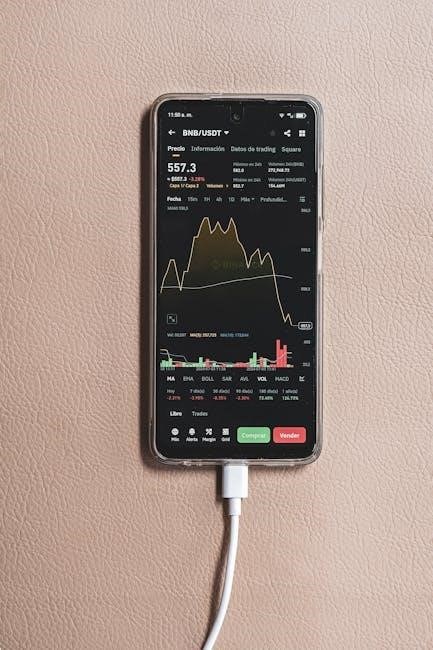An electrical work price list PDF is a comprehensive guide for contractors, outlining services and costs. It ensures transparency, consistency, and efficient project management, aiding business growth and customer satisfaction.
Overview of Electrical Work Pricing
Electrical work pricing encompasses the costs associated with materials, labor, and services required to complete various electrical tasks. It is essential for contractors to provide clear and structured pricing to ensure transparency and build trust with clients. A well-defined price list helps customers understand what they are paying for, reducing misunderstandings and disputes. Electrical pricing can vary based on factors such as the complexity of the job, the location, and the contractor’s expertise. Additionally, pricing must account for overhead expenses, profit margins, and market rates to ensure the contractor’s sustainability. Accurate and competitive pricing is crucial for attracting clients and maintaining a strong reputation in the industry.
By offering detailed pricing, electrical contractors can demonstrate professionalism and reliability, making it easier for customers to make informed decisions.
Importance of a Price List for Electrical Contractors
A price list is a vital tool for electrical contractors, as it provides clarity and transparency in pricing for clients. It helps establish trust by detailing the costs of materials, labor, and services upfront, reducing the risk of misunderstandings. A well-structured price list enables contractors to showcase their professionalism and reliability, which can attract more customers. Additionally, it streamlines the bidding and invoicing processes, saving time and minimizing errors. By having a standardized price list, contractors can ensure consistency in their pricing, making it easier for clients to compare services and make informed decisions. Moreover, it serves as a marketing tool, highlighting competitive rates and special offers. Ultimately, a price list is essential for building long-term client relationships and maintaining a strong reputation in the electrical contracting industry.
It also helps contractors to manage their finances more effectively by ensuring accurate cost calculations and fair profit margins.

Understanding the Components of an Electrical Work Price List
An electrical work price list outlines the costs of materials, labor, and services, providing a clear breakdown of pricing for various electrical tasks and projects.
It ensures transparency and helps clients understand what they are being charged for, fostering trust and professionalism in electrical contracting services.
Material Costs in Electrical Work
Material costs in electrical work encompass the expenses for components like wires, circuits, switches, outlets, and fixtures. These costs vary based on the quality, brand, and availability of materials.

Factors such as market demand, supplier pricing, and the specific requirements of a project influence material expenses. Electrical contractors often source materials from trusted suppliers to ensure reliability and cost-effectiveness.
In a price list, material costs are typically itemized to provide clarity. This helps clients understand the breakdown of expenses and ensures transparency in billing. Regular updates to material prices are essential to reflect market changes.
By detailing material costs, contractors can demonstrate professionalism and justify the overall pricing of their electrical services, building trust with clients and ensuring fair billing practices.
Labor Costs and Rates
Labor costs in electrical work represent the fees charged for the time and expertise of electricians. These rates vary based on the electrician’s experience, location, and the complexity of the task.
Labor rates are often calculated on an hourly basis, with prices ranging from $50 to $150 per hour, depending on the region and the electrician’s qualifications. For larger projects, some contractors may offer flat-rate pricing for labor.
In a price list, labor costs are typically itemized separately from materials to provide clear visibility. This transparency helps clients understand how labor contributes to the total cost of the electrical services.
Regular updates to labor rates are necessary to reflect changes in wages, demand, or market conditions. Accurate labor pricing ensures fair compensation for electricians and transparent billing for clients.
Service Charges and Additional Fees
Service charges and additional fees are essential components in an electrical work price list, covering costs beyond direct labor and materials. These fees often include service call charges, emergency response fees, or charges for diagnostics.
Service charges may be flat rates, such as $75 to $150 for a service call, or variable rates depending on the nature of the work. Additional fees might cover overtime, after-hours work, or travel expenses.
These charges are typically outlined separately in the price list to ensure transparency. They help electrical contractors cover operational costs and provide clients with a clear understanding of all potential expenses.
Regularly reviewing and updating these fees ensures they remain fair and aligned with market standards. Clear communication of service charges prevents misunderstandings and builds trust with clients.
Common Electrical Tasks and Their Pricing
Common electrical tasks include installing outlets, light fixtures, and circuit breakers, with prices ranging from $100 to $300 per task. Wiring a room or house typically costs between $300 and $2,000, depending on complexity. Troubleshooting and minor repairs often range from $75 to $150 per hour.
For larger projects, such as whole-house rewiring, costs can escalate to $2,000–$4,000. Emergency services may incur higher rates, especially after hours. Factors like location, contractor expertise, and materials influence final pricing.
A detailed price list ensures transparency, helping clients understand costs upfront. This clarity aids in budgeting and decision-making, fostering trust between contractors and customers.
How to Create an Electrical Work Price List
To create an electrical work price list, start by identifying common services and their costs. Research competitors and calculate material, labor, and overhead expenses. Determine profit margins and organize prices clearly, ensuring transparency and competitiveness. Regularly update the list to reflect market changes and customer needs, ensuring compliance with local regulations. Use templates or software for ease and accuracy, and consider customer feedback for final adjustments. This structured approach helps in developing a comprehensive and effective price list.
Determining Material and Labor Costs
Accurately determining material and labor costs is crucial for creating a realistic electrical work price list. Start by researching the current market prices of materials, such as wiring, circuits, and fixtures, ensuring to account for potential price fluctuations. Labor costs should be based on the hourly rates of electricians, considering their skill levels and the complexity of tasks. Additionally, factor in overhead expenses like tools, equipment, and transportation. To ensure precision, break down each service into material and labor components, estimating the time required for completion. Using industry standards and historical data can provide a reliable baseline. Finally, compare your calculations with competitors to ensure competitiveness while maintaining profitability. This thorough approach ensures your price list reflects accurate costs and aligns with market expectations.
Calculating Overhead and Profit Margins
To ensure sustainability and profitability, electrical contractors must account for overhead and profit margins when creating a price list. Overhead expenses include office rent, insurance, marketing, and equipment maintenance. These costs are typically calculated as a percentage of total labor and material expenses. Profit margins, on the other hand, are added to cover business goals and growth. A common approach is to apply a flat overhead rate, such as 15-25%, to the total cost of a project. Profit margins can range from 20-50%, depending on market conditions and service complexity. For example, if materials and labor cost $1,000, adding a 20% overhead ($200) and a 30% profit margin ($360) results in a final price of $1,560. Accurate calculation of these elements ensures the price list reflects both business needs and customer expectations.
Organizing the Price List for Clarity
A well-organized electrical work price list is essential for clarity and professionalism. Start by categorizing services or materials into logical groups, such as installations, repairs, or maintenance. Use tables or lists with clear headings like “Service,” “Description,” and “Price.” Include item codes or reference numbers for easy lookup. Avoid overcrowding by using whitespace effectively and breaking down complex tasks into sub-items. For larger lists, add section headers or dividers to separate categories. Consider adding notes or legends to explain symbols or abbreviations. Finally, ensure the pricing is highlighted for quick reference. This structure helps clients and team members understand the offerings and costs without confusion. A clear format enhances trust and efficiency in quoting and billing processes.
Updating the Price List Regularly
Regular updates to the electrical work price list are crucial to reflect changing market conditions, material costs, and labor rates. Prices for materials like wiring, circuit breakers, and panels can fluctuate due to supply chain issues or inflation. Labor costs may also increase with industry standards or regional demand. Additionally, new services or technologies, such as smart home installations, may need to be added. Contractors should review and revise their price list quarterly or bi-annually to ensure accuracy. Updating also helps to avoid undercharging or overcharging clients, maintaining profitability and customer trust. It’s important to communicate changes clearly to customers and ensure the updated list is easily accessible, whether in print or digital formats. Regular updates keep the business competitive and aligned with current market expectations.

Using Electrical Work Price List Templates
Using templates simplifies creating a price list, saving time and ensuring consistency. They include pre-designed sections for materials, labor, and services, allowing easy customization for specific jobs. This ensures professional presentation and accuracy, attracting clients with clear pricing.
Benefits of Using PDF Templates
Using PDF templates for your electrical work price list offers numerous advantages. They provide a professional and clean presentation, making your pricing structure clear and easy to understand. PDF templates are cost-effective and time-efficient, as they eliminate the need to design a document from scratch. They are also easily distributable to clients and teams, ensuring everyone has access to the same information. Additionally, PDF templates are secure, as they cannot be easily altered, maintaining the integrity of your pricing data. They also allow for consistency across all your documents, enhancing your brand’s professional image. Overall, PDF templates streamline the process of creating and sharing price lists, saving you time and resources while maintaining a polished appearance.
Customizing Templates for Specific Services
Customizing templates for specific services ensures your electrical work price list aligns with the unique needs of each project. By tailoring templates, you can highlight relevant services, such as residential wiring, commercial installations, or specialized tasks like smart home setups. This allows clients to focus on the services they require without being overwhelmed by irrelevant information. Customization also enables you to showcase your expertise in particular areas, enhancing your credibility. Additionally, it allows for the inclusion of detailed descriptions, images, or diagrams specific to the service, making the price list more informative. Regularly updating and adapting templates ensures they remain relevant to your target market and reflect your company’s evolving offerings. This personalized approach not only improves client satisfaction but also helps in streamlining your business operations and communication.
Step-by-Step Guide to Using a Price List Template
Using a price list template simplifies the process of creating and managing your electrical work pricing. Start by selecting a template that matches your business needs, such as one tailored for residential or commercial services. Next, input your company’s details, including logo, contact information, and branding elements; Customize the categories to reflect your services, such as wiring, installations, or repairs. Enter accurate pricing for materials, labor, and additional fees, ensuring clarity and transparency. Review the template to ensure all information is up-to-date and relevant. Finally, save the document in PDF format for easy sharing and professional presentation. Regularly update the template to reflect changes in costs or service offerings, ensuring your price list remains accurate and competitive. This step-by-step approach helps maintain consistency and professionalism in your pricing documentation.

Advanced Pricing Strategies for Electrical Contractors

Implement dynamic pricing, bundle services, and flat-rate models to maximize profitability and customer satisfaction in competitive markets.

Flat-Rate Pricing vs. Time and Material Pricing
Flat-rate pricing offers customers a fixed cost for specific electrical tasks, providing clarity and eliminating surprises. Time and material (T&M) pricing, however, charges based on actual labor hours and materials used. Flat-rate is ideal for standard, predictable jobs, while T&M suits complex or unpredictable projects. Contractors often prefer flat-rate for its simplicity and transparency, ensuring clients know upfront costs. T&M, however, allows flexibility for unforeseen issues. Balancing these methods can enhance customer trust and profitability. Choosing the right approach depends on the job’s nature and client preferences, ensuring fair pricing and clear communication. Understanding both models is essential for electrical contractors to tailor their pricing strategies effectively.
Dynamic Pricing Based on Market Conditions
Dynamic pricing allows electrical contractors to adjust their rates based on current market conditions, ensuring competitiveness and profitability. This strategy considers factors like demand fluctuations, material cost changes, and competitor pricing. For instance, prices may increase during peak demand periods, such as summer for AC installations, or decrease during slower seasons. By monitoring market trends, contractors can optimize their pricing to align with customer willingness to pay. This approach also enables flexibility in response to unexpected events, like material shortages or economic shifts. While dynamic pricing requires regular monitoring, it helps contractors maintain profit margins and adapt to evolving market dynamics. Implementing this strategy effectively can enhance customer satisfaction and business sustainability.

Bundle Pricing for Common Electrical Services
Bundle pricing is a strategy where electrical contractors offer multiple services at a discounted rate when purchased together. This approach attracts customers seeking convenience and cost savings. Common bundles include installation of outlets and switches, circuit upgrades, or lighting systems. By packaging services, contractors can increase customer satisfaction and encourage larger projects. For example, a homeowner needing multiple repairs may opt for a bundle, reducing individual service calls. This method also streamlines pricing for contractors, simplifying customer quotes. Bundle pricing enhances value perception, fostering long-term relationships and repeat business. Contractors can tailor bundles to address frequent customer needs, making it a win-win strategy for both parties. Regularly reviewing and updating bundles ensures they remain relevant and profitable.

Best Practices for Maintaining an Electrical Work Price List
Regularly update pricing, ensure transparency, and maintain clarity. Use software for accuracy and accessibility to keep the price list current and customer-friendly.
Regular Updates to Reflect Market Changes
Regular updates to an electrical work price list are essential to reflect market changes, ensuring accuracy and competitiveness. Material costs, labor rates, and service charges can fluctuate due to supply chain shifts, inflation, or regional demand. Contractors should review and adjust pricing quarterly or as needed, monitoring supplier prices, fuel costs, and labor market trends. Additionally, staying informed about industry standards and competitor pricing helps maintain relevance. Automated software integration can streamline updates, reducing manual errors. Regular revisions also allow electrical contractors to adapt to emerging technologies or new service demands. By keeping the price list current, businesses can avoid undercharging or overcharging, ensuring profitability and customer trust. Regular updates also enable clear communication of price adjustments to clients, fostering transparency and long-term relationships.
Ensuring Transparency in Pricing

Ensuring transparency in pricing is crucial for building trust with clients and maintaining a positive reputation. Electrical contractors should clearly outline all costs, including materials, labor, and service charges, in their price list. Avoiding hidden fees and providing detailed breakdowns of charges helps clients understand the value they receive. Transparent pricing also involves communicating any potential additional costs upfront, such as emergency service fees or overtime rates. By being open and honest about pricing, contractors can foster long-term customer relationships and reduce disputes. A transparent price list also demonstrates professionalism and integrity, setting the business apart from competitors. Regularly reviewing and updating the price list ensures that clients are not overcharged or misled, further enhancing trust and satisfaction.
Integrating the Price List with Electrical Software
Integrating an electrical work price list with electrical software enhances efficiency and accuracy in project management. Contractors can import or link their price list to software like QuickBooks, ServiceTitan, or FieldPulse, streamlining estimating and invoicing processes. This integration allows for automatic retrieval of prices, reducing manual entry errors and saving time. It ensures consistency across estimates and invoices, reflecting current pricing and promoting transparency with clients. Regular updates within the software are crucial to maintain accurate costs and adapt to market changes. This integration also aids in tracking cost trends and adjusting prices accordingly. By centralizing pricing data, contractors can manage projects more effectively, enhance client trust, and maintain a competitive edge in the market.